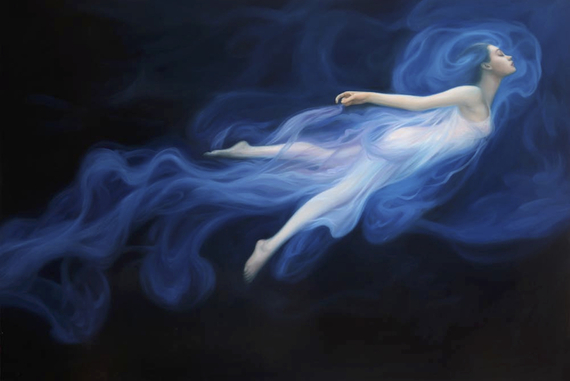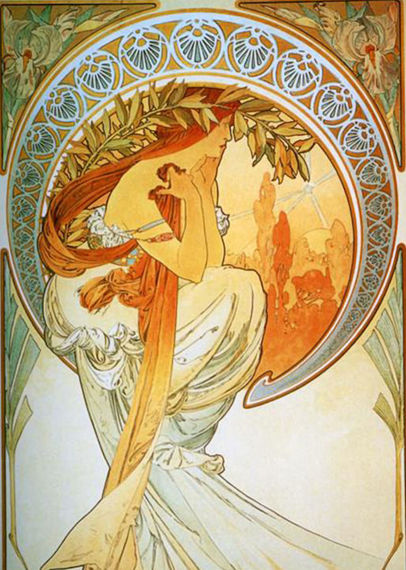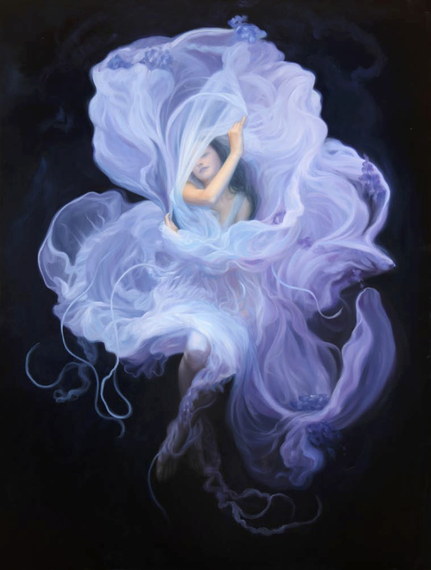Here, let's look at a Dorian Vallejo painting.
Ascent (68x46) oil on canvas
Vallejo's solo show, "A Dream Within a Dream," is at Sirona Fine Art in Hallandale Beach, Florida until March 27. To a contemporary eye, his paintings can be difficult to place -- are they illustrations or art? Are they naive or self-conscious? Are the women in them acceptable or not? May we enjoy them, or ought we to scoff?
My program, as ever, is to find a way to look at everything, to enjoy everything: to see without ruling out for as long as possible. With regard to Vallejo's work, I think we can best do this if we recognize what it is, and avoid demanding that it partake of virtues outside its sphere.
Vallejo is a practitioner of something I would tend to call the aesthetic feminine. His paintings focus on women. These women are differentiated within stereotypes, but they are not psychologically individualized. They flow seamlessly into the formal design schemes which dominate the paintings. This mode of representation is ancient, appearing in its feminized form in, for instance, the Minoan bull dancer paintings on Crete.
fresco at Knossos, Crete
The aesthetic feminine has almost always focused on dance, dance-like motion or fertility, whereas the aesthetic masculine (in Sumerian reliefs, for instance, or the Elgin marbles) generally focuses on labor and battle. While the aesthetic masculine has gone into decline in the past few centuries, the aesthetic feminine has appeared in form after form. The nymphs of Waterhouse and the pre-Raphaelites evolved within decades into the maidens of Mucha and the entire art nouveau system.
Alphonse Mucha, Poetry, 1898
To be presented with work inside this paradigm today, which neither answers to the individualistic psychological preoccupations of the realists, nor to the conceptual apparatus of the postmodernists, is disorienting; what I am proposing here is that to ask for psychology or conceptualism from Vallejo's work is to ask it to be something it isn't.
It is lilting work, fixed in the realm of daydreams and fantasies, played out on the inside of the eyelids on a summer afternoon. If you've ever gone over a book or an exhibit of art nouveau work, you'll have found that a shocking proportion of it is technically proficient. This is no accident; art nouveau is primarily a formal system, and answers to the stern demands of beauty. If a thing is not formally beautiful, it does not register as art nouveau at all. So all of its practitioners were good at it.
This is the criterion to which Vallejo submits himself above all -- that he be good at it. And moreover, that he offer something new to the gliding sense of the feminine curve, of the beautiful moment, which has descended as if on a breeze from Knossos to now. In the past, the extension of the complex curve from hip and waist and breast and neck, to the universe at large, was accomplished by means of plant stems, fruits and flowers, lightweight cloth gusting on the wind, and abstract elliptical arcs. Vallejo turns to the compendium of nonlinear dynamics to find and mine two new sources of the right genre of curve: the eddying of smoke, and the billowing of cloth underwater.
Light Dancer (40x45) oil on canvas
Consider the absurd difficulty of actually painting something like Light Dancer. To translate the chaotic attractors of smoke into a glowing formal composition is a grueling task; and not only to translate, but to aestheticize, to make a seemingly natural system work in a given rectangle, with a given figure mingled into it. This is much of the actual point of the painting -- it is a display of virtuosic talent, of a kind with such celebrations of prowess in meeting intricate formal aesthetics as are found, for instance, among ballet dancers, gymnasts, and violinists. It delights in itself, and we are invited to delight in it as well.
Now look at this:
Blossom (44x58) oil on canvas
Look at the diffuse overhead light, the layered planes and threads of translucent material, the weightless figure, the delicate orchestration of turquoises and mauves, the coordination of the elements into an overall sense of a flower or a jellyfish. This is a celebration of itself-ness in the key of femininity, as insubstantial as a dream, and at the same time, as substantial as the motive force of history.
I am not entirely able to set aside my requests for psychology and conceptualism in confrontation with Vallejo's work. And yet he paints with such force, such conviction, and such skill that the work demands I come out to meet it. How beautiful it is! How complete! It reminds me that if I have lost my ability to chase after beauty for its own sake; I have lost the first thing I had. And this is a loss too painful to accept. Therefore, these are notes in how I am teaching myself to be at peace in the company of Vallejo's work; I think I am on the right track with them.
Dream Ripple (71x55) oil on canvas
---
All images of Dorian Vallejo's artwork courtesy of the artist.
Minoan painting and Mucha painting via commons.wikimedia.org.
Dorian Vallejo online: http://dorianvallejo.com/
"A Dream Within a Dream," Sirona Fine Art, 600 Silks Run, #1240 Hallandale Beach, FL 33009, until March 27th. Online: www.sironafineart.com






